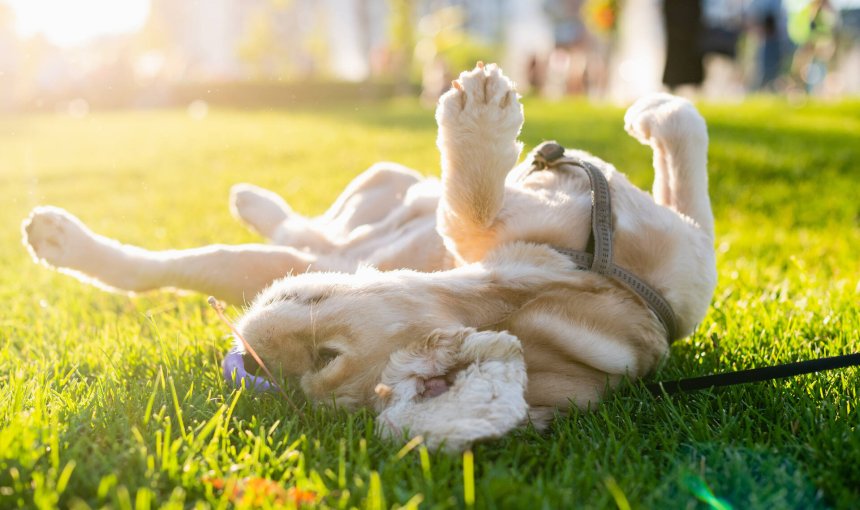 Approved by Dr. Dwight Alleyne, DVM
Approved by Dr. Dwight Alleyne, DVM How To Spot, Treat & Prevent Skin Cancer In Dogs
Here's everything you need to know about the different types, warning signs, and how you can prevent it from worsening down the line.

You might not think much about it if your buddy’s on the furrier side or you don’t live in the sunniest spot. But catching on to skin cancer in dogs early can be one of the best ways to treat it successfully. Here’s what to look out for and what changes in your buddy’s normal behavior might signal a cause for concern.
Key Takeaways
Skin cancer is one of the most common types of tumors in dogs. It can affect any breed, especially older dogs or those with light-colored skin and thin coats.
You should regularly check your dog’s skin for any unusual growths like bumps, lumps, sores that won’t heal, or spots that change color (like pink, red, black, or gray). Early detection is the best way to treat it successfully.
The Tractive smart dog tracker can act like an early warning system for your dog’s health. If they become less active, start losing weight, or seem more reluctant to play, the tracker’s Activity Monitoring can alert you to a change in their normal routine. More often than not, this can be an early sign of an underlying illness.

Always know your buddy is healthy & safe
Read moreWhat causes skin cancer in dogs?
Cancer in general is a “multifactorial” disease, which means it has no known single cause. But it may develop as a result of your dog’s genetic history. In fact, genetic mutations contribute to the development of mast cell tumors. Certain viruses, hormonal abnormalities, and environmental factors (like chemicals in your dog’s environment and how much sun exposure they get) can all play a role.
Which dogs are most at risk for skin cancer?
Although it can affect any breed at any age, dogs with light-colored skin or a thin coat may be most at risk for sun-related skin cancer1. There may be a genetic basis for the development of certain cancers, especially for:
- Boxers
- Scottish Terriers
- Golden Retrievers
- Norwegian Elkhounds
- German Shepherds
- Bull Mastiffs
- Weimaraners
- Basset Hounds
Likewise, senior dogs are also much more in the “risk zone” than younger ones.
What are the signs of skin cancer in dogs?
Skin cancer on dogs can show up in several different ways, depending on which form of cancer it is. Keep an eye out for any unusual:
- Bumps
- Lumps
- Sores
- Lesions
- Scabs
- Raised patches
- Discoloration on your dog’s skin
- Spots that are pink, red, black, brown, or grey in color
- Wounds that don’t heal
- Abnormal swelling that persists or continues to grow
- Weight loss
- Loss of appetite, including difficulty eating or swallowing
- Bleeding or discharge from any body opening
- Lethargy, including seeming less active or more reluctant around walks and playtime
- Persistent lameness or stiffness
- Difficulty in breathing and urinating
- Excessive itching
It’s best to make an appointment with your vet as soon as possible if you notice something strange on your dog’s skin, or if your dog appears to be in pain. If you find a tumor on your dog, try not to touch it, and don’t let your dog chew, lick or scratch it. This is more likely to worsen the situation and needs immediate medical attention. If your pet has any of these cancer symptoms, or any other signs of illness in dogs, head to your vet right away.

Get health alerts for your dog
Our pups can’t always tell us if something’s wrong. But if their tracker detects unusual changes in their routine, you’ll get an alert, helping you catch potential issues early.
What are the types of skin cancer in dogs?
Now the good news: even though there are different types of dog skin cancer, not all tumors are malignant or cancerous. In fact, if your vet notices any suspicious bumps or lumps, they might take a biopsy to determine whether it’s benign or malignant. Some of the most common types include:
- Mast cell tumors
- Squamous cell carcinoma
- Malignant melanoma
- Histiocytic cell tumors
- Fibrosarcoma
Mast cell tumors
MCTs are one of the most common types of skin cancer in dogs. Thankfully, they’re also considered one of the most treatable. Mast cells release histamine, a chemical that causes allergic reactions in dogs and turns up as itching. Tumors made of mast cells can grow anywhere on a dog’s skin as well as in internal organs like the spleen, intestine, liver, and bone marrow.
Here are some signs of mast cell tumors in dogs:
- Common: a raised, possibly red or swollen bump or lump on or under the skin; stomach or intestine ulcers, which may cause lethargy, vomiting, loss of appetite, and black stools
- Possible: anaphylaxis (allergic reaction)
- Rare: swollen lymph nodes, spleen, or liver, round or swollen belly
Most often, mast cell tumors are found on the legs, lower belly, and chest of dogs. Most dogs with mast cell tumors only develop one tumor.3
Dogs breeds most susceptible to mast cell tumors
- Pugs
- Boxers
- Boston Terriers
- Bull Terriers
- Rhodesian Ridgebacks
- Labrador Retrievers
Mixed breed, older dogs are also most susceptible to MCTs. This type of skin cancer is most often seen in dogs aged 8 to 10 years old.
Squamous cell carcinoma
Another very common type of dog skin cancer is squamous cell carcinoma. This type of cancer is often triggered by exposure to the sun and usually appears as a single lesion. The term “squamous” refers to the top layer of the skin, where tumors can develop in the cells. Commonly found around the nails, paw pads, abdomen, ears, back, or nose, it may be mistaken as a minor abrasion. Which is why it;s essential to diagnose and treat it early, otherwise squamous cell carcinoma can spread to surrounding tissue or other parts of the body.
Dogs breeds most susceptible to squamous cell carcinoma
- Scottish Terriers
- Pekingese
- Boxer Dogs
- Poodles
- Norwegian Elkhounds
- Whippets
- Beagles
- Dalmations
- Bull terriers
Fine coated, light-haired, and light-skinned dogs are more prone to squamous cell carcinoma.
Read more: Dogs And Heat: How To Keep Dogs Cool In Summer
Malignant melanoma
Melanomas often appear as raised, sometimes dark bumps near your dog’s mouth or nail bed. Many melanomas in dogs are benign, but sometimes they can be malignant. In the latter case, they pose a serious risk to your dog’s health and well-being and require urgent treatment. Fast growing, this type of cancer can spread quickly to other parts of the body.
Any dog breed can get melanoma, and it is typically found in dogs 10 years or older. Besides, small dog breeds, black dogs, and male dogs are more susceptible to developing this form of skin cancer. Schnauzers and Scottish Terriers are also more at risk.
How would my vet treat my dog’s condition?
Cancer treatment in dogs can vary and depends on the type and stage of cancer. The most common treatments include:
- Surgery
- Chemotherapy
- Radiation
- Immunotherapy – though a mixture of therapies is also a possibility.
- In some cases, your vet might also provide your dog palliative care, including pain relief.
Your vet should, however, make regular skin checks a priority – especially as your buddy grows older.
How to prevent skin cancer in dogs
Make regular grooming (and skin checks) a priority
With regular brushing and grooming, you don’t just keep your dog’s fur tangle-free – you also catch on to any weird bumps, lumps, and swellings early on. It can also help rid your dog’s skin of any dead skin cells and help you spot any areas with patchy fur much in advance. (Especially around the belly, ears, and armpits.)
Keep an eye out for any moles or spots and if they change in size and shape. Also, avoid shaving your dog’s fur. This can increase their exposure to UV radiation during the warmer months. Your vet can best advise you what dog-friendly products to use instead that won’t irritate your dog’s skin.
Be extra mindful of the sun
While this is important for all dogs, watch out if you’ve got a light-colored, thin-coated, or hairless dog at home. Limit the time they spend in the sun, especially between 10 AM to 4 PM when UV radiation is at its peak. Provide your dog plenty of shade to spend time in, like an umbrella or canopy in your backyard. Or consider installing shades, curtains, or UV-blocking protective window films indoors.
You could also use a dog-friendly sunscreen recommended by your vet on spots where your dog’s skin is the thinnest, like their nose, ears, belly, and hindquarters. Avoid using any products on your dog that are built for humans, as they’re more likely to be toxic to animals. Likewise, avoid walking your dog outdoors with the sun directly overhead. Besides, hot pavements or asphalt roads can irritate the skin around your dog’s paws.
Finally, never leave your dog in a car with the windows down! This can increase their risk of both UV exposure and overheating.
Watch out for harmful chemicals in your environment
Like, for example lawn chemicals, like pesticides or fertilizers. If your dog likes to spend time digging around or playing in your backyard, you’re better off using pet-safe alternatives that won’t accidentally poison them instead. Mark off any treated areas in your backyard with fences, rocks, or any other barriers to deter your dog from approaching them. Keep an eye out for other, common household items that might be toxic to dogs. Including tobacco smoke, harsh cleaning products, and other potential carcinogens.
Keep an eye out for any changes in your dog’s behavior
A sick dog might withdraw to handle their discomfort by themselves. Which is where your only hint is to keep an eye out for any changes in their behavior – which might indicate something’s not right. Like if they’re suddenly:
- Hiding or withdrawing more than usual.
- Seeming more reluctant to eat
- Not drinking enough water – or, on the other hand, drinking too much water
- Scratching themselves excessively – or even rubbing their faces or scooting their butts across the floor to relieve some discomfort
- Licking or even biting their fur excessively
Get in touch with your vet if you notice any of these behavioral changes – but also any change in your dog’s skin, including any growths, bumps, or lumps, spots, moles, or any bleeding sores. Your vet is most likely to ask you when these symptoms began and how long they’ve been persisting.
Where a Tractive smart dog tracker can help
A smart dog tracker can help you manage your dog’s environment to support their skin health, especially regarding sun exposure, which can contribute to certain skin cancers. Strapped to your dog’s collar, you can use your Tractive device’s Location History to check where your dog spends time outdoors. If the Heatmap shows they’re consistently lying in a spot that receives intense, direct sun exposure for long periods, you can modify that area or encourage them to use a shady spot. This helps you manage their environment to better protect their skin.

Your tracker also helps you monitor for subtle changes in behavior that might signal a problem, like discomfort, pain, or a change in the condition. If a cancerous lesion or a surgical site is causing pain or discomfort, your dog may become less active or experience poor, restless sleep. With its built-in motion detector, your tracker monitors your dog’s activity and sleep. If it detects a sudden, significant change in these patterns, you’ll receive an instant Health Alert. So you now have an early warning system that something is off, prompting you to get them checked at the vet.
Your furry friend’s health and wellbeing means as much as to us as it does to you. So we’ve made it a priority to only share medically-relevant content on our blog. This post was checked, double-checked, and medically verified by Georgia-based vet, Dr. Dwight Alleyne.

Dr. Dwight Alleyne, DVM
Originally from Long Island, New York, Dr. Alleyne began his career at a no-kill animal shelter before becoming a licensed veterinary technician. He graduated from Cornell University Veterinary College in 2006 and completed an internship at Purdue University. Now practicing in Georgia, Dr. Alleyne specializes in soft tissue surgery and ultrasounds. He also writes pet health articles on his website, “The Animal Doctor Blog” (www.anmldrblog.com).




